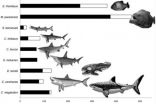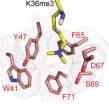(Press-News.org) Taking into consideration its size, an ancient relative of piranhas weighing about 20 pounds delivered a bite with a force more fierce than prehistoric whale-eating sharks, the four-ton ocean-dwelling Dunkleosteus terrelli and – even – Tyrannosaurus rex.
Besides the force of the bite, Megapiranha paranensis appears to have had teeth capable of shearing through soft tissue the way today's piranhas do, while also being able to pierce thick shells and crack armoring and bones, according to Stephanie Crofts, a University of Washington doctoral student in biology.
"If our calculations are correct, Megapiranha was probably a bone-crushing predator taking bites of anything and everything," she said. Crofts is co-author of "Mega-Bites: Extreme jaw forces of living and extinct piranhas," published Dec. 13 in the online journal Scientific Reports.
The bite force of Megapiranha, which lived 10 million years ago, was extrapolated from the first field measurements of the biting force of Earth's largest piranha today, Serrasalmus rhombeus or black piranha. One 2 ½ pound fish delivered a bite with a force of 320 newtons, or about 72 pounds, which is 30 times its body weight. The force is nearly three times greater than the bite force of an equivalent size American alligator.
Based on the 2 ½ pound piranha and other specimens tested in the wild, the scientists calculate that Megapiranha paranensis, which weighed approximately 22 pounds, could have had a bite force anywhere from 1,240 to 4,750 newtons – or 280 to 1,070 pounds – and possibly more.
Other scientists have previously estimated that T. rex slammed its jaws shut with 13,400 newtons, or 3,000 pounds of force, but that's nowhere near 30 times its body weight.
Pound for pound, Megapiranha and black piranha have the most powerful bites among carnivorous fishes, living or extinct, the paper said. "For its relatively diminutive size, Megapiranha paranensis' bite dwarfs other extinct mega-predators" including the enormous whale-eating Carcharodon megalodon and the monstrous Dunkleosteus terrelli, a four-ton armored fish.
The same was true when the scientists corrected for body size and made comparisons with today's barracudas, hammerhead sharks and great white sharks.
"We were surprised that in spite of their long history and infamous reputations that no one had ever measured their bite forces," said Justin Grubich, with the American University in Cairo, Egypt, and lead author of the paper. "When we finally started to get the data, we were blown away at how tremendously strong the bites were for these relatively little fish."
As the paper says, "While anecdotes of piranha-infested waters skeletonizing hapless victims are generally hyperbole, the effectiveness of their bite is not."
Just how does one measure the bite force of a piranha living in the wild? Well, you get out your rod and reel and go fishing. Land a specimen, then hang tight to the tail with one hand and use your other hand to support its belly while offering the fish a chance to bite the plates of a customized force gage.
"Piranhas are ornery little fish so they bit down as hard as they could," Crofts said based on what she was told by those on the fishing expedition along tributaries of the Amazon River.
The black piranha's bite is so powerful in part because of its massive jaw muscles and rope-like tendons that together account for 2 percent of the fish's overall weight, the scientists found. Further the shape of their jaw has evolved into a powerful lever, "one of the highest jaw-closing mechanical advantages ever identified in fishes," the paper said.
Crofts' main contribution involved analysis of how Megapiranha teeth handled stresses and how breakable the teeth might have been. The scientists were particularly interested because Megapiranha's unusual teeth appear to do two things at the same time, one the piranha-like ability to shear soft tissues and the other an ability to bite like the nut-crushing pacu, piranha's close relative.
Based on a fossilized jaw and three teeth, Crofts conducted a computer generated "finite element analysis" for the team.
"We found the Megapiranha teeth had the same maximum strength like you saw in regular piranha, but then the patterns of stress distribution within the tooth was also similar to fish able to eat hard-prey," she said.
The actual diet remains a mystery, but during the time when Megapiranha lived a lot of potential prey species were gigantic.
"Thus it is reasonable to assume the food resources available to Megapiranha would likely have required jaw forces and dental weaponry capable of capturing and processing very large prey," the paper says.
INFORMATION:
Other co-authors on the paper are Steve Huskey with Western Kentucky University, Guillermo Orti with George Washington University and Jorge Porto with the Instituto Nacional de Pesquisas da Amazônia.
Funding came from the National Geographic and the Field Museum of Natural History.
For more information:
Crofts, croftss@uw.edu, phone for Crofts ask Sandra Hines.
Suggested websites
Paper
National Geographic video on YouTube – with Justin Grubich
Stephanie Crofts
Piranha kin wielded dental weaponry even T. rex would have admired
2012-12-27
ELSE PRESS RELEASES FROM THIS DATE:
Doctors call for evidence-based appropriateness criteria for elective procedures
2012-12-27
Many of the most common inpatient surgeries in the United States are performed electively. These surgeries are expected to significantly increase with the enactment of the Affordable Care Act. In a new perspectives article, published in the Dec. 27 edition of The New England Journal of Medicine, a team of Weill Cornell Medical College researchers are recommending the nation's health care leaders and medical community join forces to establish evidence-based appropriateness criteria to determine which patients are most in need of elective procedures, such as joint replacement ...
UNC research uncovers new insight into cell development and cancer
2012-12-27
CHAPEL HILL - Long-standing research efforts have been focused on understanding how stem cells, cells capable of transforming into any type of cell in the body, are capable of being programmed down a defined path to contribute to the development of a specific organ like a heart, lung, or kidney. Research from the University of North Carolina at Chapel Hill School of Medicine has shed new light on how epigenetic signals may function together to determine the ultimate fate of a stem cell.
The study, published December 27, 2012 by the journal Molecular Cell, implicates ...
Genetic sequencing breakthrough to aid treatment for congenital hyperinsulinism
2012-12-27
Congenital hyperinsulinism is a genetic condition where a baby's pancreas secretes too much insulin. It affects approximately one in 50,000 live births and in severe cases requires the surgical removal of all or part of the pancreas.
Researchers at the University of Exeter Medical School are the first in the world to utilise new genetic sequencing technology to sequence the entirety of a gene in order to identify mutations that cause hyperinsulinism. Previously, existing technology limited such sequencing to only part of the coding regions of the gene which meant that ...
Cellular fuel gauge may hold the key to restricting cancer growth
2012-12-27
Researchers at McGill University have discovered that a key regulator of energy metabolism in cancer cells known as the AMP-activated protein kinase (AMPK) may play a crucial role in restricting cancer cell growth. AMPK acts as a "fuel gauge" in cells; AMPK is turned on when it senses changes in energy levels, and helps to change metabolism when energy levels are low, such as during exercise or when fasting. The researchers found that AMPK also regulates cancer cell metabolism and can restrict cancer cell growth.
The discovery was made by Russell (Rusty) Jones, an assistant ...
Stowers study hints that stem cells prepare for maturity much earlier than anticipated
2012-12-27
KANSAS CITY, MO—Unlike less versatile muscle or nerve cells, embryonic stem cells are by definition equipped to assume any cellular role. Scientists call this flexibility "pluripotency," meaning that as an organism develops, stem cells must be ready at a moment's notice to activate highly diverse gene expression programs used to turn them into blood, brain, or kidney cells.
Scientists from the lab of Stowers Investigator Ali Shilatifard, Ph.D., report in the December 27, 2012 online issue of Cell that one way cells stay so plastic is by stationing a protein called Ell3 ...
Evidence contradicts idea that starvation caused saber-tooth cat extinction
2012-12-27
In the period just before they went extinct, the American lions and saber-toothed cats that roamed North America in the late Pleistocene were living well off the fat of the land.
That is the conclusion of the latest study of the microscopic wear patterns on the teeth of these great cats recovered from the La Brea tar pits in southern California. Contrary to previous studies, the analysis did not find any indications that the giant carnivores were having increased trouble finding prey in the period before they went extinct 12,000 years ago.
The results, published on ...
MRI can screen patients for Alzheimer's disease or frontotemporal lobar degeneration
2012-12-27
PHILADELPHIA - When trying to determine the root cause of a person's dementia, using an MRI can effectively and non-invasively screen patients for Alzheimer's disease or Frontotemporal Lobar Degeneration (FTLD), according to a new study by researchers from the Perelman School of Medicine at the University of Pennsylvania. Using an MRI-based algorithm effectively differentiated cases 75 percent of the time, according to the study, published in the December 26th, 2012, issue of Neurology®, the medical journal of the American Academy of Neurology. The non-invasive approach ...
Drug shortage linked to greater risk of relapse in young Hodgkin lymphoma patients
2012-12-27
A national drug shortage has been linked to a higher rate of relapse among children, teenagers and young adults with Hodgkin lymphoma enrolled in a national clinical trial, according to research led by St. Jude Children's Research Hospital.
Estimated two-year cancer-free survival for patients enrolled in the study fell from 88 to 75 percent after the drug cyclophosphamide was substituted for mechlorethamine for treatment of patients with intermediate- or high-risk Hodgkin lymphoma. The study was launched before the drug shortages began. The change occurred after a mechlorethamine ...
Drug shortage linked to greater risk of relapse in young Hodgkin lymphoma patients
2012-12-27
STANFORD, Calif. — A national drug shortage has been linked to a higher rate of relapse among children, teenagers and young adults with Hodgkin lymphoma enrolled in a national clinical trial, according to research led by St. Jude Children's Research Hospital.
Estimated two-year cancer-free survival for patients enrolled in the study fell from 88 to 75 percent after the drug cyclophosphamide was substituted for mechlorethamine for treatment of patients with intermediate- or high-risk Hodgkin lymphoma. The study was launched before the drug shortages began. The change occurred ...
Kindness key to happiness and acceptance for children
2012-12-27
Children who make an effort to perform acts of kindness are happier and experience greater acceptance from their peers, suggests new research from the University of British Columbia and the University of California, Riverside.
Kimberly Schonert-Reichl, a professor in UBC's Faculty of Education, and co-author Kristin Layous, of the University of California, Riverside, say that increasing peer acceptance is key to preventing bullying.
In the study, published today by PLOS ONE, researchers examined how to boost happiness in students aged 9 to 11 years. Four hundred students ...



